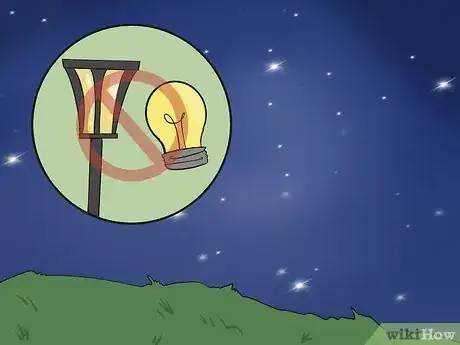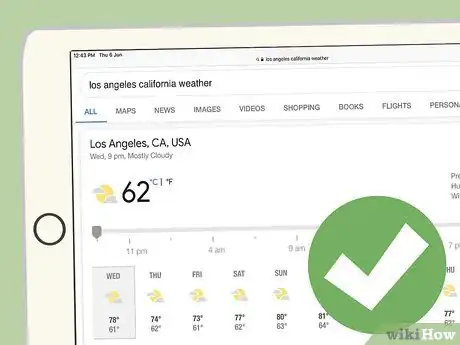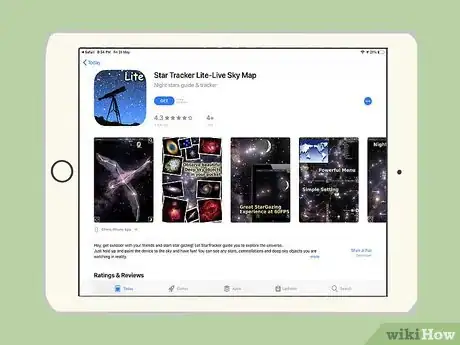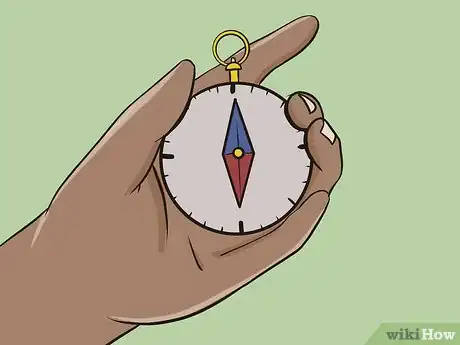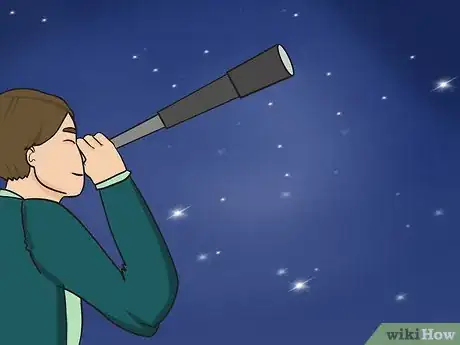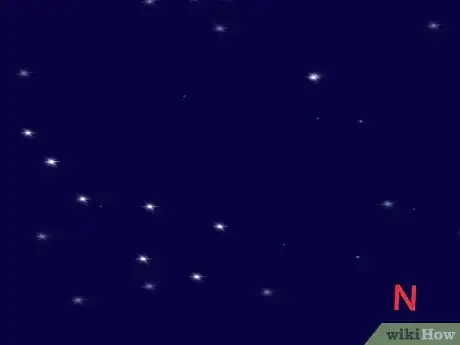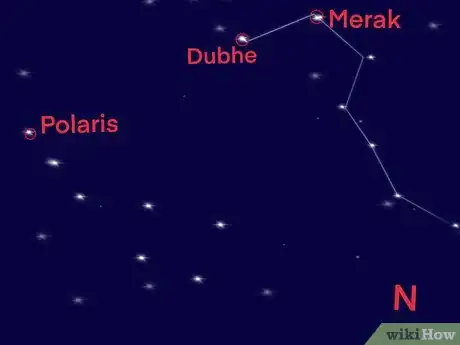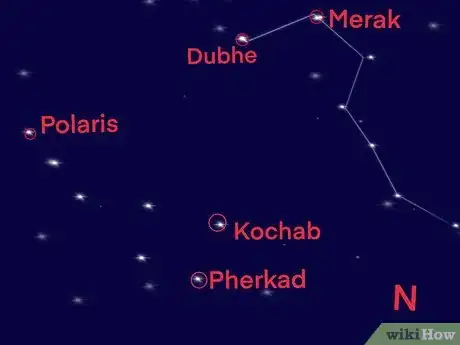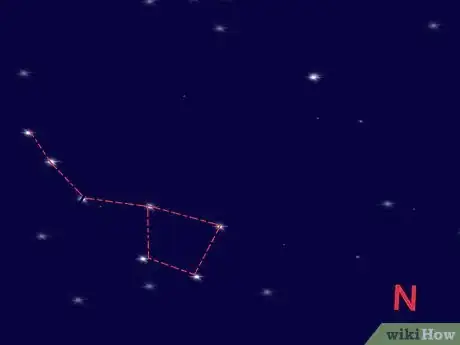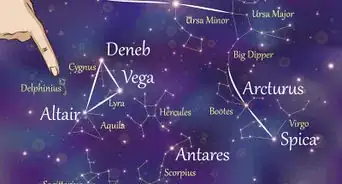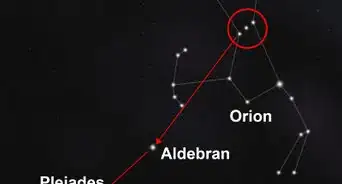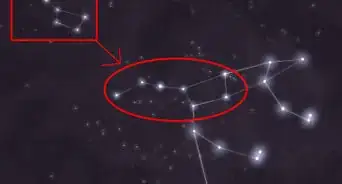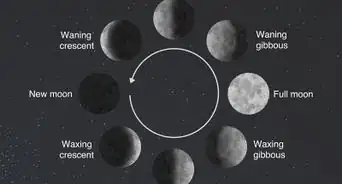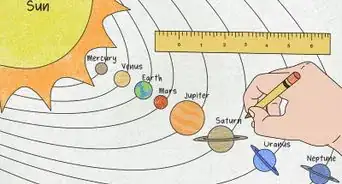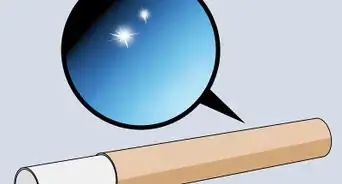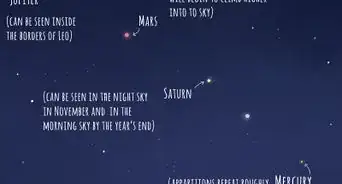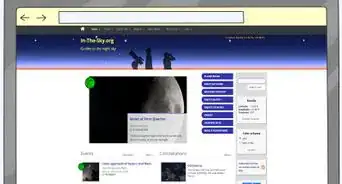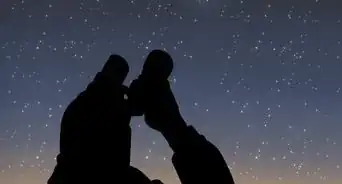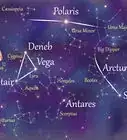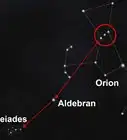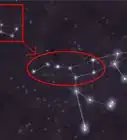This article was co-authored by wikiHow Staff. Our trained team of editors and researchers validate articles for accuracy and comprehensiveness. wikiHow's Content Management Team carefully monitors the work from our editorial staff to ensure that each article is backed by trusted research and meets our high quality standards.
There are 16 references cited in this article, which can be found at the bottom of the page.
This article has been viewed 101,296 times.
Learn more...
The Little Dipper is a well-known pattern of stars situated in the northern sky. Unlike it’s larger, brighter counterpart, The Big Dipper, The Little Dipper can be quite difficult to locate, even under good viewing conditions. The best way to catch sight of the formation is to set out on a clear night in a place with minimal light pollution and scan the night sky for The Big Dipper. You can then connect the dots of bright stars until your eyes settle on The Little Dipper.
Steps
Taking Advantage of Optimal Viewing Conditions
-
1Choose a nice, clear night to set out. Plan your outing for an evening with little or no cloud cover. Most of the stars that comprise the Little Dipper are quite dim, and even a smattering of clouds could be enough to cover it up completely.[1]
- Check your local weekly forecast to get an idea of what the weather will be like around the time of your stargazing adventure. The farther in advance you’re able to plan, the better.
- Ideally, you should wait until the moon is in a waning phase—if it’s glowing too brightly, its radiant light may make the Little Dipper appear less distinct.
-
2Find a secluded spot with minimal light pollution. Your best bet is to set out for a nearby rural or undeveloped area, if you have one in your area. If there are no good fields or clearings around, head to a corner of your town or city that’s as far away from the most heavily concentrated sources light as you can get.[2]
- Streetlamps, porch lights, and other forms of electrical illumination give off ambient light, which can “bleed” into the night sky and make heavenly bodies hazy or even invisible.[3]
- Since the Little Dipper is already so faint, too much light pollution could make it impossible to catch a glimpse.
Advertisement -
3Keep your distance from buildings, trees, and other large obstructions. The Little Dipper is so small and unassuming compared to some more impressive star patterns that a tall structure could block it from view. Picking out an open spot with few potential obstacles will improve your chances of successfully locating the modest grouping of stars.[4]
- Even things like tree telephone poles and power lines could be distracting enough to break your line of sight or throw off your concentration.
-
4Do your searching in the spring or summer to improve your chances. The position of the Little Dipper varies slightly based on the time of year. The star cluster is at its highest point in the sky from around late March to the end of September. Because of this, the warmer months tend to be the best time to turn your eyes skyward.[5]
- The movement of the Earth plays a big part in the way stars appear from ground level. Since the planet rotates on an axis, your geographic location in relation to the Little Dipper will change with the seasons, making it look higher or lower.
- While it’s technically possible to catch sight of the Little Dipper at any time of the year as long as you’re in the Northern Hemisphere, it’s much harder in the fall and winter, when the formation “drops” and is prone to getting lost in the horizon.
Tip: When attempting to locate the Little Dipper, it can help to remember the old saying “spring up and fall down.”
-
5Use virtual aids to admire the Little Dipper from the Southern Hemisphere. Don't worry if you're unable to get a firsthand view of the Little Dipper from where you live—there are many different tools and resources that will give you a glimpse. Astrology websites and digital star maps, for instance, can show you the formation's basic structure and position relative to other stars. If you'd rather hunt for it yourself, try downloading a star-finder app that offers a full 360-degree view of space, such as SkyView or Star Tracker.[6]
- The Little Dipper and the North Star are features exclusive to the northern sky. Unfortunately, that means that none of these star patterns will be directly visible if you happen to be below the equator.
- Keep in mind that there are many incredible celestial bodies to take in from the southern regions, including the Southern Cross, Alpha Centauri, the sparkling Jewel Box cluster, and the largest satellites of the Milky Way.[7]
Using Other Stars to Pinpoint the Little Dipper
-
1Point yourself north with the aid of a compass. If you don't own a traditional compass, the compass app on your smartphone or tablet will also help you get yourself oriented correctly. The northern sky is home to the Little Dipper, along with its major outlying stars: Polaris, Dubhe, Merak, Pherkad and Kochab. You'll be using these stars as guide markers to work your way toward the formation.[8]
- Digital star maps and star-finder apps often include built-in compasses to help you establish your vantage point. Some even label astral formations and the individual stars that comprise them, taking the difficulty out of identifying them yourself.[9]
-
2Search the northern sky for Polaris, the North Star. Once you're facing north, gaze high up on the horizon or straight overhead to see if you can find Polaris. Polaris is the first and most brilliant star in the Little Dipper, which means that if you find it, you’ve effectively found the Little Dipper, even if you can’t make out its full shape.[10]
- Consider buying or renting a telescope to “zoom in” on the stars and simplify the process of locating the Little Dipper and other groupings and constellations.
- If a telescope is out of your price range, you might also invest in some binoculars. A strong pair of binoculars can increase your viewing power by up to 70%![11]
- If your goal is to find the Little Dipper, Polaris will be your biggest help, as it’s the biggest and brightest star in the bunch. In order to identify Polaris, however, it may sometimes be necessary to first track down the Big Dipper.
Tip: If you’re equipped with a telescope or binoculars, the most effective strategy is to first narrow down the general vicinity of the Little Dipper with your naked eye, then pull out your viewing aid and use it to get a closer look.
-
3Keep an eye out for the Big Dipper somewhere in the vicinity of Polaris. There’s no trick for doing this—all you can do is simply look up. Start your hunt in the north, as The Big Dipper is known to rotate around the North Star. Using the Big Dipper as a reference point will make closing in on the Little Dipper a breeze.[12]
- Keep in mind that the positions of stars can appear to change depending on your location. The further south you are, for instance, the closer to the horizon the Big Dipper will be. If you’re further north, look for it in the upper reaches of the sky.[13]
- For most amateur astronomers in the continental United States, the Big Dipper is usually somewhere around the halfway point between the vertical limit of the night sky and the horizon.
-
4Look for Dubhe and Merak if you can't find Polaris or the Big Dipper. These 2 stars sit along the outer edge of the bowl of the Big Dipper. They are sometimes referred to as “pointer stars,” as they can be used to “point” the way to Polaris. Merak forms the bottom “corner” of the bowl, with Dubhe in the top corner.[14]
- Once you’ve located Merak and Dubhe, draw an imaginary line between the 2 stars, then extend this line towards the north by about 5 times its length. Somewhere around, you may be able to make out Polaris.[15]
-
5See if you can spot Pherkad and Kochab in the sky around the Big Dipper. Together, these 2 stars form the front edge of the “bowl” of the Little Dipper. Pherkad marks the upper corner of the bowl, with Kochab below it in the bottom corner. Aside from Polaris, they are the only stars in the Little Dipper that are relatively easy to see unaided.[16]
- Pherkad and Kochab are also known as "the Guardians of the Pole" because of the way they “patrol” around Polaris. They are the nearest of the bright stars to the Polaris, and therefore to Earth’s northern axis.[17]
- Kochab, a second magnitude star, is the brighter of the pair, with a distinct orange glow. Pherkad is a third magnitude star, but is still plainly visible under most conditions.
-
6Connect the dots from Pherkad to Polaris to bring the Little Dipper into view. Once you’ve singled out the three brights stars of the Little Dipper (Pherkad, Kochab, and Polaris), all that’s left to do is scan the surrounding sky for the other four stars. Finding them will complete the picture, giving you a spectacular view of one of the heavens’ most famous star formations.[18]
- If you happen to spy the “bowl” stars first, start looking for the “handle” stars. Remember that Polaris is the star at the outermost part of the handle, and that Pherkad and Kochab lie at the other end.
- Here’s a fun fact: because of the way the Earth turns, the Big Dipper and Little Dipper seem to constantly rotate around one another so that when one is upright, the other is upside down. Additionally, the handles of the 2 star patterns always point in opposite direction.[19]
Community Q&A
-
QuestionIn which direction is the Little Dipper from the Big Dipper?
 TomPNTop AnswererTypically, the Little Dipper appears north of the Big Dipper, but since they are both very close to the celestial North Pole, it tends to make concepts like North and South go a bit wacky.
TomPNTop AnswererTypically, the Little Dipper appears north of the Big Dipper, but since they are both very close to the celestial North Pole, it tends to make concepts like North and South go a bit wacky. -
QuestionDo I have to go to the country to find it?
 TomPNTop AnswererIt helps, but no, you don't have to. You can see the Big Dipper from within a city. The Little Dipper is dimmer, but you can find it if you search hard enough.
TomPNTop AnswererIt helps, but no, you don't have to. You can see the Big Dipper from within a city. The Little Dipper is dimmer, but you can find it if you search hard enough. -
QuestionWhen does it come out?
 DonaganTop AnswererIt depends on where you are. Much of the northern hemisphere can see it after dark on any clear night.
DonaganTop AnswererIt depends on where you are. Much of the northern hemisphere can see it after dark on any clear night.
Things You'll Need
- Telescope or binoculars (optional)
References
- ↑ https://earthsky.org/favorite-star-patterns/big-and-little-dippers-highlight-northern-sky/
- ↑ https://www.space.com/29649-ursa-minor-little-dipper-skywatching.html
- ↑ https://www.sciencealert.com/watch-the-dramatic-effect-light-pollution-has-on-our-view-of-the-night-sky
- ↑ https://www.accuweather.com/en/weather-blogs/astronomy/stargazing-for-beginners-planning-your-first-night-out/63296
- ↑ http://earthsky.org/favorite-star-patterns/big-and-little-dippers-highlight-northern-sky
- ↑ https://www.space.com/15346-big-dipper-southern-cross-skywatching-guide.html
- ↑ https://www.skyandtelescope.com/observing/beginners-guide-to-the-southern-hemisphere-sky/
- ↑ https://www.space.com/15567-north-star-polaris.html
- ↑ https://www.forbes.com/sites/jesseshanahan/2018/05/09/the-best-free-stargazing-apps-of-2018/
- ↑ https://solarsystem.nasa.gov/news/1944/what-is-the-north-star-and-how-do-you-find-it/
- ↑ https://skyandtelescope.org/astronomy-equipment/binoculars-for-astronomy/
- ↑ https://solarsystem.nasa.gov/news/1944/what-is-the-north-star-and-how-do-you-find-it/
- ↑ https://www.space.com/6505-find-dipper.html
- ↑ https://earthsky.org/tonight/how-to-find-the-little-dipper
- ↑ https://www.space.com/6505-find-dipper.html
- ↑ https://www.space.com/29649-ursa-minor-little-dipper-skywatching.html
- ↑ https://earthsky.org/tonight/use-big-dipper-to-find-polaris-and-little-dipper
- ↑ https://earthsky.org/tonight/how-to-find-the-little-dipper
- ↑ http://www.physics.ucla.edu/~huffman/finddip.html
About This Article
To find the Little Dipper, look for the North Star, which is the brightest star in the sky when you look directly north. It's also the brightest star in the Little Dipper constellation, and it's located at the top of the handle of the Little Dipper. Once you find the North Star, find the next 2 brightest stars in the constellation, Pherkad and Kochab, to form the front edge of the bowl. Finally, connect the dots with the surrounding stars to outline the pattern of a bowl with a handle. For more advice, including how to choose the right stargazing conditions, keep reading!

